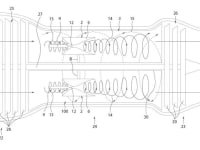
In the history of transportation, electricity has always replaced fossil fuels when a commercially viable technology was available. Historically, major manufacturers have invested in electric trains and cars and it’s clear that electric aircraft are next. However, none of the current solutions for electric planes provide engines that are adapted for large scale commercial flights. Whilst "Electric aircraft are a key element in our research for the future of aviation" as Airbus' CEO Tom Enders outlines, most efforts have focused on the classic "electromagnetic" engine for its incomparable efficiency. Yet current technologies do not offer sufficient power density for high speed flights. By applying arcjet technology to jet engines– i.e. heating air with an electrical arc instead of burning kerosene–we present a novel solution to this problem. Through clever use of bypass airflows and power levels within the arc, we overcame the limitations on plasma stability that arise when using arcjets in an atmospheric environment. By implementing arcjets in a conventional jet turbine, we are reimagining the potential of a technology the has been proven for decades in satellites as an efficient and cost-effective solution.
Major players in the field (IBM, Toyota,…) are implementing new battery technologies, such as Li-Air batteries, which will offer the same amount of energy density as kerosene, and huge increases in safety and reliability. By leveraging these advances, we provide the other side of the winning equation: lightweight and compact jet engines.
We have developed this technology with global warming in mind; the more than 814 million tons of CO2 emitted by the airline industry in 2016 (+5%/2015) contribute significantly to the greenhouse effect. The world population, which currently depends on oil for its energy consumption, could be connected on a global scale through a system that is:
- Clean (no CO2 emissions)
- Safe (solid state batteries eliminate the risk of fires in case of accidents)
- Cost effective (reduced operating and energy costs) for an industry whose profitability is extremely variable
- Vast array of generation sources (windmills, solar panels…)
Simulations show that over the past 10 years the Turboarcjet is cost effective. The fuel costs of aggregated airlines worldwide amounted to $130 Billion in 2016 and jet kerosene prices (20%-35% of operating costs) are much more volatile than electricity prices. Depending on energy prices, the comparative cost of the Turboarcjet ranges from breakeven to a 30% reduction. Thus replacing fuel with electricity represents up to a $30 Billion annual savings for the industry. Considering that the airline industry’s ROIC – WACC became positive in 2015 for the first time since 2000, this kind of cost reduction could be game-changing.
After having the theoretical work validated by leading experts in the field, a team of Yale Engineers is developing the prototype and is supported by the Yale School of Engineering and Applied Sciences.
Video
-
Awards
-
 2017 Top 100 Entries
2017 Top 100 Entries
Like this entry?
-
About the Entrant
- Name:Xavier Morin
- Type of entry:teamTeam members:Xavier Morin Kai Dougan Danielle Lotridge Miles Petterson
- Software used for this entry:SolidWorks
- Patent status:pending





